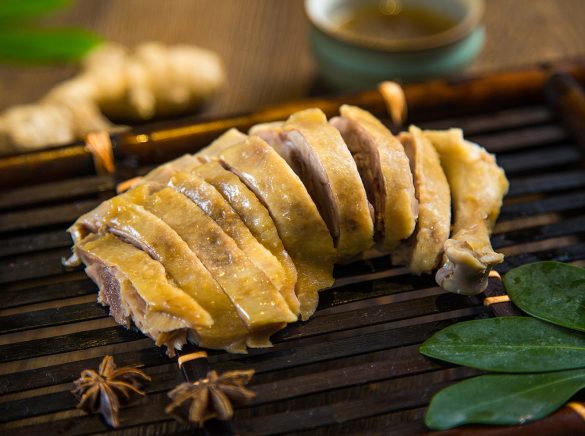As the osmanthus flowers release their intoxicating fragrance in the fall, heralding a season of harvest and abundance, there’s a culinary tradition that captures this essence perfectly—the making of the Nanjing Salted Osmanthus Duck. A renowned delicacy hailing from the ancient city of Nanjing, also known as Jinling, this dish has been savored for over two and a half millennia. Bearing the prestigious title of a Geographical Indication product in China, the Nanjing Salted Duck is celebrated for its succulent flesh, which is tender, flavorful, and rich without being greasy, encapsulating the aromatic, crisp, and tender trifecta of culinary perfection.
The most exquisite variety of this dish, named after the fragrant osmanthus, is prepared around the Mid-Autumn Festival when the flowers are in full bloom, enhancing the duck’s flavor and aroma. The preparation of Salted Duck is an art that honors the innate savor of the duck, embracing simplicity to eliminate excess oil and strong odors while preserving its delectable freshness and tender juiciness. Regular consumption of this dish is believed to offer anti-inflammatory benefits and slow down aging, making it particularly suitable for those with cardiovascular conditions.
The traditional preparation of Nanjing Salted Duck is a meticulous process that involves “rubbing with matured salt, reviving with aged brine, drying to perfection, and cooking thoroughly.” The matured salt rub refers to the initial curing stage, where salt is stir-fried with spices to enhance its penetrating power, eliminate thermophilic bacteria, and augment the flavor. The aged brine is a combination of fresh and aged solutions; the fresh brine is made by boiling stir-fried salt with aromatic spices, while the aged brine, enriched over multiple uses, imparts a profound savory richness to the duck. The quality of the aged brine is highly prized, with century-old brines considered treasures of the culinary world.

Drying the duck after the brine bath reduces the fat content and tightens the skin, while the low-temperature cooking preserves the duck’s moisture, maintaining its juicy nature. High-temperature cooking, on the other hand, can compromise the flavor, resulting in a dish that smells delightful but tastes mediocre. The final product is tender, fragrant, and leaves a lasting impression on the palate.
During my university days in Hefei, I would often pass through Nanjing, never missing the chance to bring some Salted Duck for the train ride, making the journey less tiring. In the United States, where potlucks are common, Salted Duck is an excellent choice for its convenience and superb taste. My approach, which closely follows ancient methods, may be laborious, but the result—a tight-skinned, non-greasy, tender, and savory duck—is well worth the effort. The reaction is always the same: amazement!
Ingredients: The Essence of Autumn:
- Duck: 1 whole
- For curing:
- Coarse sea salt: 100g
- Sichuan peppercorns: 5g
- Star anise: 2
- Five-spice powder: 3g
- Ginger powder: 3g
- Osmanthus flowers: 3g
- For the clear brine:
- Rough salt: approx. 200g (adjusted for water volume)
- Ginger slices: 4
- Green onion: 1
- Star anise: 1
- For cooking:
- Green onion: 1
- Ginger slices: 3
- Star anise: 1
- Cinnamon bark: 1 piece
- Bay leaves: 2
- Cardamom pods: 2
- Huadiao wine: 15ml

The Process: Crafting the Delicacy:
- Clean the duck and soak it in water for about two hours, keeping the blood water.
- Stir-fry the coarse salt with spices until the salt grains turn slightly yellow, enhancing the flavor.
- While the salt is still warm, rub it thoroughly over the duck, inside and out.
- Sprinkle with osmanthus flowers, cover with cling film, and cure for four hours, refrigerating if necessary.
- For the clear brine, combine the duck, blood water, and enough fresh water to cover the duck in a large pot and bring to a boil. Add the brine ingredients and the remaining stir-fried salt, continuing to add salt to saturation, then simmer covered for one hour.
- Filter the clear brine through a fine sieve to remove impurities, resulting in an amber-colored liquid.
- Soak the duck in the clear brine, ensuring it’s fully submerged, without removing any curing remnants.
- Use a stone to weigh down the duck, soaking for 2 hours in summer, 7 hours in winter, or 4 hours at around 18 degrees Celsius.
- Dry the duck in a convection oven at 70 degrees Celsius (170 degrees Fahrenheit) for 35-45 minutes until the skin tightens and some fat is rendered.
- Prepare the cooking ingredients.
- Cook the duck in a pot with enough water to cover, along with all the cooking ingredients, at a temperature just below boiling, around 90 degrees Celsius, for an hour.
- Weight the duck down in the water, uncovered, turning halfway through.
- Remove the duck, pour the skimmed duck oil from the water over it, and let it cool before refrigerating.
- When ready to serve, slice the duck, sprinkle with osmanthus flowers, and enjoy.
- The final dish boasts a creamy white skin, tender and slightly rosy meat, a subtle saltiness, and a harmonious blend of fragrance, freshness, and tenderness that is endlessly enjoyable, whether as an accompaniment to drinks or a snack.

